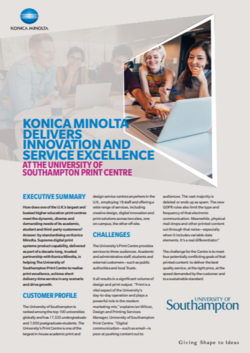University of Southampton
Print Centre

Discover how the University's Central Reprographics Department has evolved into a modern Communications Hub.
How does one of the U.K.’s largest higher education print centres meet the dynamic and diverse needs of its academic, student and third-party customers?
Answer: by standardising on Konica Minolta.
Supreme digital print systems product capability, delivered as part of a decade-long, trusted partnership with Konica Minolta, is helping The University of Southampton Print Centre to realise print excellence, achieve short delivery-time service in any scenario and drive growth.
Fill in the form to download this case study
KCS PrintWorks
See how using the latest in Konica Minolta print technology KCS PrintWorks are able to produce higher quality prints, with a quicker turnaround and can provide their customers with a more diverse range of print solutions.
They can now offer a fast, bespoke digital service.

Artificial Intelligence and Robotics - According to the blog, the rise of AI and robotics shows no sign of slowing down, with “more and more of our work and personal tasks will be taken over in the next decade by cognitive systems, autonomous vehicles, bots and drones, as interconnectivity, data aggregation and analytics move forward”.
Flatter Corporate Hierarchies - The evolution from the industrial age to digital means less layers in management hierarchy with a more diverse and flexible workforce – where employees can move along horizontal, vertical and diagonal paths. The ‘Corporate Lattice’ brings about more opportunities, multi-skilled and empowered employees.
The ‘Gig’ Economy - Mobile working brings mobile workers. According to Konica Minolta, “the appetite of employers for mobility and flexibility, coupled with millennials’ thirst for more blended work and personal time is helping to drive a new kind of workforce”. Skilled freelancers can find their talents better matched to varied roles that further empowers the workforce.
‘Second Tier’ Cities - With remote working high on the agenda, employees don’t necessarily have to live and work in the main city hotspots, which also have the highest living costs. Some organisations and government departments are setting up satellite offices in ‘second tier’ cities, where it’s cheaper to live and do business but still attracting the same level of skilled workers.
Being at Work Anywhere - The advent of technologies such as augmented reality and virtual reality, amongst others, have revolutionised how and where we work. The digital workplace becomes an extended workplace that is flexible and collaborative while remaining a ‘personal’ experience.

